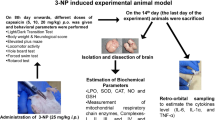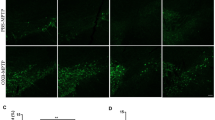Abstract
This study focuses on evaluation of the toxic effect of enduslfan (END) and the quercetin (QUE) role in rat striatum. END (2 mg/kg) associated or not with QUE (10 mg/kg), was daily administered to animals during 6 days. Then, striatum mitochondria suspension was prepared by centrifugation to assess mitochondria swelling and redox status by determining malondialdehyde (MDA), glutathione-s-transferase (GST), catalase (CAT) and Glutathion (GSH). In addition, striatal lysate was also elaborated to determine apoptosis markers caspases-9 and 8; B-cell lymphoma2 (Bcl2) and Bcl2 associated X (Bax), by applying luminescence and ELISA methods. This study has shown an increase in mitochondria swelling and induction of apoptotic pathway. In addition, a decrease in mitochondrial enzymatic activity of GST and CAT was recorded as well as an increase in mitochondrial MDA rate and a fall in mitochondrial GSH level. By contract, QUE has maintained oxidative stress and apoptotic markers at their homeostasis levels and prevented striatum mitochondria swelling. Thus, endosulfan impairs redox status and membrane integrity of striatum mitochondria and induces apoptosis, but the use of QUE avoids these alterations.
Similar content being viewed by others
References
Fattach, N. in Les polluants organiques persistants. Thèse de doctorat de l’université de Mohammed V Souissi. (Université of Mohammed V, Rabat, Marocco, 2010).
Lahouel, A. et al. Nurobehavioral deficits and brain oxidative stress induced by chronic low dose exposure of persistent organic pollutants mixture in adult female rat. Environ. Sci. Pollut. Res. 23, 19030–19040 (2016).
Ruzzin, J. et al. Persistent Organic Pollutant Exposure Leads to Insulin Resistance Syndrome. Environ. Sci. Pollut. Res. 118, 465–471 (2010).
Lee, S. E. et al. Endosulfan Induced Biomarkers in Japanese Rice Fish (Oryzias latipes) analyzed by SELDI-TOF-MS. Int. J. Biol. Sci. 9, 343–349 (2013).
Chevallier, A. in Etude du rôle du récepteur aux hydrocarbures aromatiques ou AhR dans le développement et l’homéostasie du système nerveux de la souris C57BL/6J. Human health and pathology (Université Rene Descartes -Paris V publication, France, 2012).
Barnig, C., Kopferschmitt, M. C. & De Blay, F. Syndrome d’hypersensibilité chimique multiple: physiopathologie et clinique Multiple chemical sensitivities: Pathophysiology and clinical aspects. Rev. Fr. Aller. Immunol. Clin. 47, 250–252 (2007).
Rychen, G. et al. La chaîne alimentaire vectrice de polluants organiques persistants. Cah. Nutr. Diet. 41, 139–146 (2006).
Verner, M. A. in Caractérisation de la variabilité interindividuelle dans la Toxicocinétique des polluants organiques persistants chez L’humain (Université du québec, Montréal, 2012).
UNEP in Global Report 2003-Regionally Based Assessment of Persistent Toxic Substances (UNEP chemicals, Geneva Switzerland, 2003).
UNEP (United Nations Environment Programmme). in Chemicals. Regionally based assessment of persistent toxic substances -Antarctica regional report (UNEP chemicals, Geneva, 2009).
Vandelac, L. & Bacon, M. H. Perturbateurs endocriniens et pollants organiques persistants: inquiétante erosion de la santé, dela fertilité et de la capacité intellectuelle. Ruptures, revue transdisciplinaire en santé 6, 237–267 (1999).
Baldi, I. et al. in Pesticides. Effets sur la sante. Collection expertise collective (Ed. Inserm, Paris, France, 2013).
Moon, J. M. & Chun, B. J. Acute endosulfan poisoning: a retrospective study. Hum. Exp. Toxicol. 28, 309–316 (2009).
Ambolet-Camoit, A. et al. Les pollutants organiques persistants: implication dans l’obésité et le syndrome métabolique. Cah. Nutr. Diet. 47, 183–192 (2012).
Hossain, M. M. et al. Acute Effects of Pyrethroids on Serotonin Release in the Striatum of Awake Rats: An In Vivo Microdialysis Study. Biochem. Mol. Toxicol. 27, 150–156 (2014).
Lakroun, Z. et al. Oxidative stress and brain mitochondria swelling induced by Endosulfan and protective role of quercetin in rat. Environ. Sci. Pollut. Res. 22, 7776–7781 (2015).
Mor, F. & Ozmen, O. Effect of vitamin C in reducing the toxicity of endosulfan in liver in rabbits. Exp. Toxicol. Pathol. 62, 75–80 (2010a).
Mor, F. & Ozmen, O. Endosulfan-induced neurotoxicity and serum acetyl cholinesterase inhibition in rabbits: The protective effect of Vit C. Pesticide Biochem. Physiol. 96, 108–112 (2010a).
Stoytcheva, M. in Pesticide-The Impacts of Pesticide Exposure (Published by InTech Janeza Trdine 9, 51000 Rijeka, Croatia, 2011).
Kang, K. S. et al. Effects and neuro-toxic mechanisms of 2,2',4,4',5,5'-hexaclorobiphenyl and en dosulfan in neuronal stem cells. J. Vet. Med. Sci. 63, 1183–1190 (2001).
Chan, M. P. L. et al. Development of an in vitro blood-brain barrier model to study the effects of endosulfan on the permeability of tight junctions and a comparative study of the cytotoxic effects of endosulfan on rat and human glial and neuronal cell cultures. Envir. Toxicol. 21, 223–235 (2006).
Ballesteros, M. L. et al. Endosulfan induces changes in spontaneous swimming activity and acetyl cholinesterase activity of Jenynsia multidentata (Anablepidae, Cyprinodontiformes). Environ. Pollut. 157, 1573–1580 (2009).
Silva, M. H. & Gammon, D. An assessment of the developmental, reproductive and neurotoxicity of endosulfan. Birth Defects Res. Part B Dev. Reprod. Toxicol. 86, 1–28 (2009).
Sunol, C. et al. Studies with neuronal cells: from basic studies of mechanisms of neurotoxicity to the prediction of chemical toxicity. Toxicol. In Vitro. 22, 1350–1355 (2008).
Yang, X., Chang, H. Y. & Baltimore, D. Essential role of CED-4 oligomerization in CED-3 activation and apoptosis. Science 281, 1355–1357 (1998).
Froelich, C. J., Dixit, V. M. & Yand, X. Lymphocyte granule-mediated apoptosis: matters of viral mimicry and deadly proteases. Trends Immuno. 19, 30–36 (1998).
Ye, L., Chaohua, Y. & Nina, F. S. Apoptosis in the absence of caspase 3. Oncogene 20, 6570–6578 (2001).
Lafuente, A. & Pereiro, N. Neurotoxic effects induced by endosulfan exposure during pregnancy and lactation in female and male rat striatum. Toxicol. 311, 35–40 (2013).
Brunelli, E. et al. Environmentally relevant concentrations of endosulfan impair development, metamorphosis and behaviour in Bufobufo tadpoles. Aqua. Toxicol. 91, 135–142 (2009).
Iwanicka, N. B. & Borzecki, A. Sub acute poisoning of mice with Deltaméthrin produces memory impairment, reduced locomotor activity, liver damage and changes in blood morphology in the mechanism of oxidative stress. Pharmacol. Rep. 67, 535–541 (2015).
Jia, Z. & Misra, H. P. Developmental exposure to pesticides zineb and/or endosulfan renders the nigrostriatal dopamine system more susceptible to these environmental chemicals later in life. NeuroToxicol. 28, 727–735 (2007).
Scremin, O. U. et al. The environmental pollutant endosulfan disrupts cerebral cortical function at low doses. NeuroToxicol. 32, 31–37 (2011).
Khan, P. K. & Sinha, S. P. Impact of higher doses of vitamin-C in modulating pesticide genotoxicity, Teratogen. Carcinogen. Mutagen. 14, 75–181 (1994).
Muttaka, A., Abdullahi, J. & Sule, M. S. Toxicological Studies of the Aqueous Leaves Extracts of Combretum micranthum on Rats. Int. J. Biochem. Biotechnol. 12, 167–171 (2016).
Clayton, D. A. & Doda, J. N. in Cells: A Laboratory (eds Manual. D. L. Spector, R. Goldman & L. Leinwand) 356–361 (Sci. Pub Press, Beijing, China, 2001).
Farhi, S. et al. The neurotoxicity study of cadmium on oxidative stress parametres and the protective effect of sélénium on this toxicity in rabbitis. J. Trace Elem. Med. Biol. 29, 4–10 (2015).
Bradford, M. A. Rapid and sensitive method for the quantitation of microgram quantities of prtein utilizing the principle of protein-dye binding. Anal. Biochem. 72, 248–254 (1976).
Clairborne, A. in Catalase activity In CRC, Handbook of Methods for Oxygen Radical Research (CRC Press, Boca Raton, FL., 1985).
Habig, W. H., Pabst, M. J. & Jakoby, W. B. Glutathione S-transferases. The first enzymatic step in mercapturic acid formation. Biol. Chem. 249, 7130–7139 (1974).
Ellman, G. L. Tissue sulfhydryl groups. Arch. Biochem. Biophys. 82, 70–77 (1959).
Ohkawa, H., Ohishi, N. & Yagi, K. Assay of lipid peroxides in animal tissue by thiobarbituric reaction. Anal. Biochem. 95, 351–358 (1979).
Ahmed, M. B. et al. Neurotoxic effect of lead on rats: relationship to apoptosis. Int. J. Health Sci. 7, 192–199 (2013).
Author information
Authors and Affiliations
Corresponding author
Rights and permissions
About this article
Cite this article
Lakroun, Z., Kebieche, M., Lahouel, A. et al. Potentiation of apoptosis in rat striatum exposed to endosulfan and the role of quercetin. Toxicol. Environ. Health Sci. 9, 229–236 (2017). https://doi.org/10.1007/s13530-017-0325-1
Received:
Revised:
Accepted:
Published:
Issue Date:
DOI: https://doi.org/10.1007/s13530-017-0325-1




